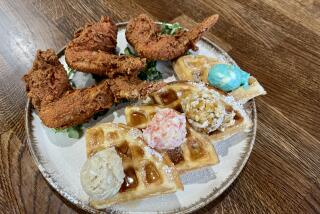Q: What is the chemical reaction that...
- Share via
Q: What is the chemical reaction that produces butter from milk?
A: It is not a chemical reaction, but a physical one. Milk secreted by a cow contains very small globules of fats, surrounded by a protein membrane, suspended in fluid. These globules are stable for long periods of time but if the milk is agitated, the membranes rupture and the fat gathers into larger, visible particles called butter granules. The liquid they float in, called buttermilk, is drained away. The granules are then washed and pressed into the blocks you buy at the grocery story. About 20 pounds (10 quarts) of milk are required to produce one pound of butter.
Anthropologists speculate that the first butter was discovered by prehistoric nomadic tribesmen who carried milk in bags hung on the backs of pack animals. The motion of walking would have churned the milk, allowing the butter to separate. Hindus recorded their fondness for butter more than 3,500 years ago, and there are many references to it in the Bible. The ancient Greeks and Romans used it as a hair dressing and a skin ointment as well as a food. The Romans are known to have preferred the taste of rancid butter.





